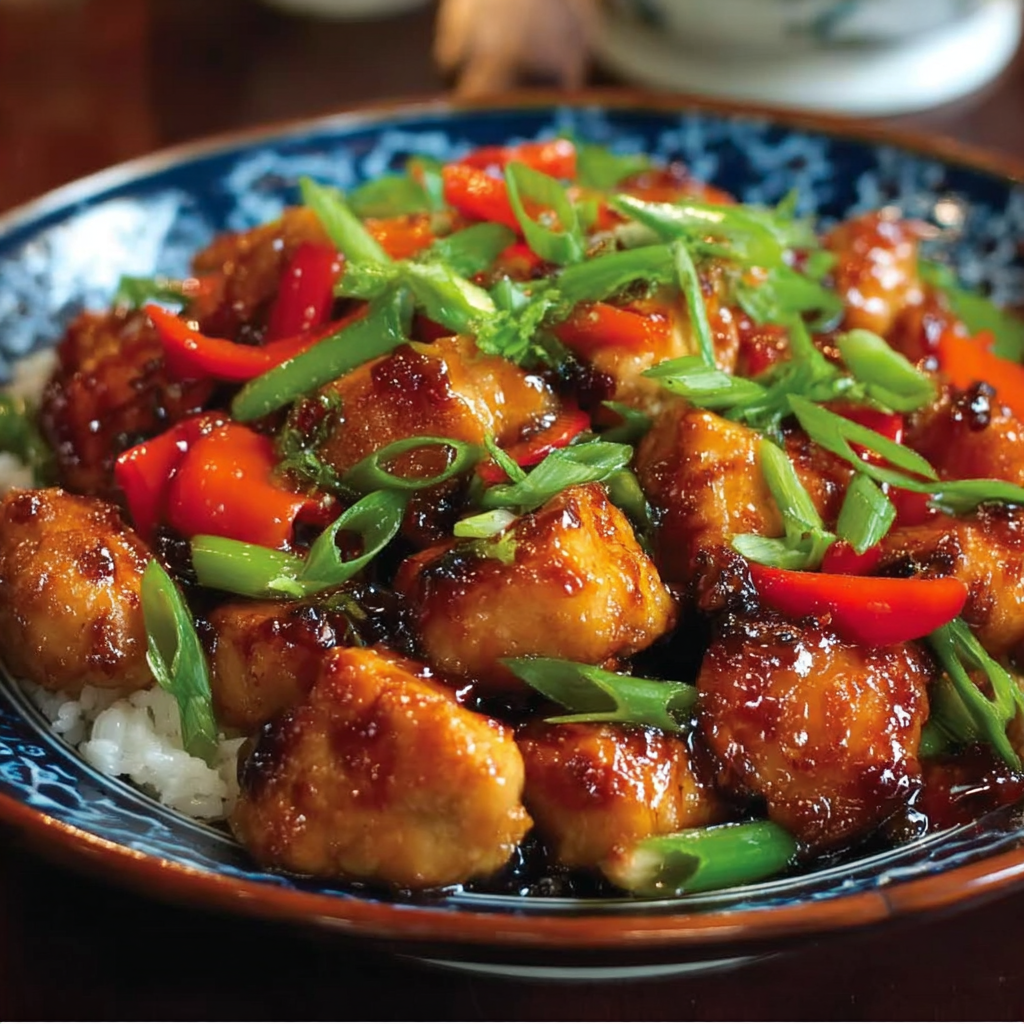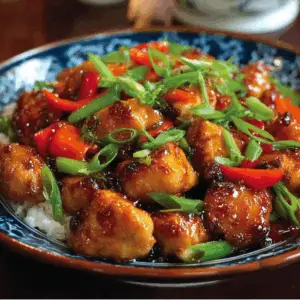The Rise of Mongolian Chicken as a Weeknight Staple
In the world of quick and flavorful dinners, Mongolian Chicken has emerged as a reliable favorite. Though its name suggests a deep connection to Mongolian cuisine, this dish is actually an American-Chinese restaurant creation, much like its beef counterpart. Designed to deliver bold flavors in minimal time, Mongolian Chicken combines crispy slices of chicken in a sweet and savory sauce, often infused with garlic, ginger, and soy. The result is a sticky, satisfying stir fry that feels like takeout but cooks up faster than delivery.
Historically, Mongolian cuisine centers around meat, dairy, and hearty stews—ideal for the cold steppes of Central Asia. You can explore more about authentic Mongolian culinary traditions by reading about Mongolian cuisine, which gives cultural context to this American adaptation. What makes this Mongolian Chicken recipe a true weeknight winner isn’t just its flavor profile—though that’s a major draw—but also its speed and flexibility.
It uses pantry staples like soy sauce and cornstarch to create a thick, restaurant-style sauce, and cooks quickly thanks to thinly sliced chicken breast. Home cooks who crave something simple yet bold can find this dish as satisfying as any takeout option. For those browsing boards like Quick Dinner Ideas on Pinterest, this recipe checks all the boxes—speed, flavor, and family appeal.
As stir fry recipes grow in popularity due to their adaptability and ease, this dish also belongs in the family of modern stir-fry classics. To learn more about this cooking technique, read about how stir-frying works, especially if you’re trying to master fast, high-heat cooking at home.
Whether you’re meal prepping or scrambling to make something in 30 minutes, Mongolian Chicken delivers on its promise: a perfect balance of savory soy, warm ginger, and brown sugar sweetness, all caramelized over a hot pan. It’s the kind of recipe that belongs on your “easy weeknight dinners” rotation, offering reliable results with very little fuss.
2. Why You’ll Love This Mongolian Chicken Recipe
There are countless reasons why Mongolian Chicken has become a go-to dinner option for busy home cooks, but what really sets this recipe apart is its simplicity and versatility. It’s the kind of dish that feels indulgent but is surprisingly easy to make with pantry staples. Here’s why this recipe deserves a permanent spot on your weeknight menu:
-
Quick Cooking Time: The entire dish comes together in just 30 minutes, making it ideal for nights when you need something fast without sacrificing flavor. The chicken cooks quickly thanks to the thin slices and high heat of the stir-fry method.
-
Minimal Ingredients, Maximum Flavor: You only need a handful of ingredients—like soy sauce, garlic, ginger, and brown sugar—to build an umami-rich sauce that tastes like it came straight from your favorite restaurant. These staples, including garlic and ginger, form the flavor base that gives the sauce its signature kick.
-
Family-Friendly: This sweet-and-savory flavor profile appeals to both kids and adults. You can easily dial up or down the heat by adjusting the red pepper flakes, making it suitable for all palates.
-
Customizable: You can adapt this recipe in endless ways. Swap the protein, add vegetables, or use gluten-free ingredients without compromising the essence of the dish. For ideas and inspiration, explore easy Asian recipes on Pinterest, where you’ll find plenty of variations to suit your taste.
-
Budget-Friendly: This dish uses affordable ingredients you likely already have in your kitchen. It’s a cost-effective way to enjoy Asian-inspired flavors without ordering takeout.
With its balance of convenience, adaptability, and flavor, Mongolian Chicken is the kind of meal that satisfies cravings while fitting effortlessly into a busy schedule. It’s easy to see why it’s become such a popular recipe across food blogs, Pinterest boards, and weeknight dinner rotations.
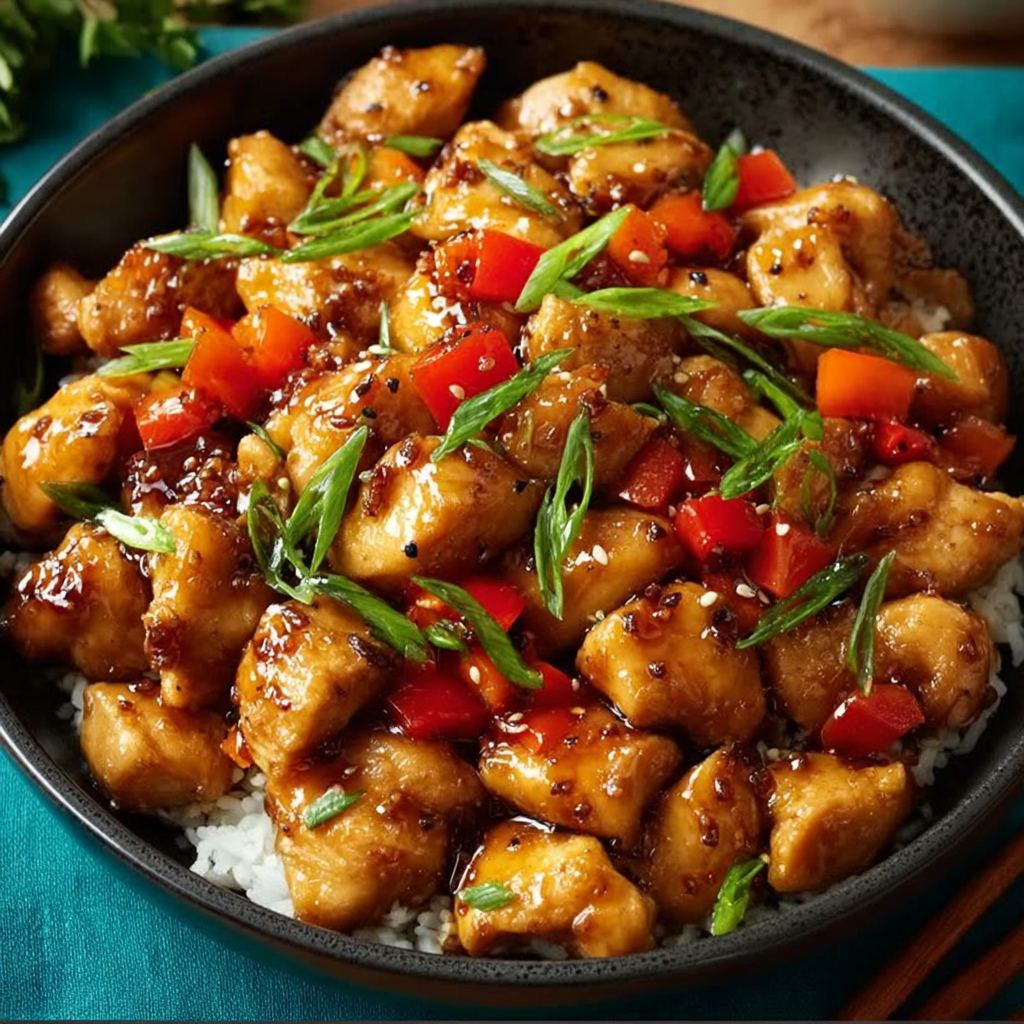
3.Key Ingredients and Their Roles
Creating a rich and satisfying Mongolian Chicken starts with a careful selection of simple yet flavorful ingredients. Each component of this dish plays a distinct role, contributing to the final balance of sweet, savory, and umami. Below is a breakdown of each ingredient and why it matters in achieving that signature taste and texture.
-
Chicken Breast (1.5 lbs, thinly sliced):
Lean and quick-cooking, boneless, skinless chicken breast serves as the protein base. Its mild flavor allows the sauce to shine, while its tender texture absorbs the glaze beautifully. Alternatively, chicken thighs can be used for a juicier result. -
Cornstarch (¼ cup):
Tossing the chicken in cornstarch creates a thin coating that crisps when stir-fried, forming a lightly crunchy exterior that holds the sauce. It also thickens the glaze when added to the pan. -
Vegetable Oil (2 tbsp):
Neutral in flavor, this oil helps achieve the high heat required for stir-frying. It allows the chicken to sear quickly without burning. -
Garlic (3 cloves, minced):
Provides bold aromatic flavor. Garlic is one of the base notes that gives Mongolian Chicken its unmistakable savory depth. -
Fresh Ginger (1 tsp, grated):
A traditional staple in Asian cooking, ginger adds warmth and zing to the dish. You can explore its culinary role further through ginger’s culinary uses. -
Low-Sodium Soy Sauce (½ cup):
The foundation of the sauce. This provides saltiness and umami, but using a low-sodium variety prevents the dish from becoming overpoweringly salty. More on soy sauce basics is available here. -
Water (½ cup):
Dilutes the sauce slightly, ensuring it coats the chicken evenly without reducing too quickly. -
Brown Sugar (⅓ cup):
This ingredient adds the perfect level of sweetness, creating a caramel-like quality when simmered with soy sauce. It’s what gives the dish its iconic sweet-savory character. -
Crushed Red Pepper Flakes (½ tsp, optional):
Adds heat and dimension. This can be adjusted or omitted based on spice preference. -
Green Onions (2, sliced for garnish):
Offers a fresh contrast to the rich sauce and provides a mild oniony crunch. -
Cooked White Rice (for serving):
The perfect base for soaking up the flavorful sauce. While jasmine rice is common, cauliflower rice can be used for a low-carb alternative. Check stir fry recipes for more serving ideas.
This ingredient lineup makes it easy to prepare a meal that’s both accessible and impressive. If you’re looking to enhance your kitchen skills further, review the method of how stir-frying works to master the quick-cook technique behind this dish.
Together, these components form a harmonious balance that captures what makes Mongolian Chicken a standout weeknight dinner.
4.Step-by-Step Instructions with Cooking Tips
Preparing Mongolian Chicken is quick, but the right techniques make a big difference in flavor and texture. Follow these steps closely, and you’ll get that crispy chicken and sticky savory sauce every time. Below is a breakdown of the method along with pro tips to ensure success.
1. Coat the Chicken Properly
-
Start by placing the thinly sliced chicken breast in a bowl with the cornstarch. Toss to coat each piece evenly, making sure all sides are covered.
-
Tip: Shake off any excess cornstarch to prevent clumping during cooking.
Why it matters: Cornstarch creates a light crust on the chicken, helping it crisp up and hold onto the sauce.
2. Sear the Chicken in Batches
-
Heat vegetable oil in a large skillet or wok over medium-high heat.
-
Add the chicken in a single layer—do not overcrowd the pan.
-
Cook until golden brown and crispy on all sides. This should take about 5–7 minutes.
-
Remove and set aside.
Pro Tip: If needed, cook in two batches to avoid steaming the chicken. For more detail, learn about the benefits of stir-frying in hot oil.
3. Build the Flavor Base
-
In the same skillet, reduce the heat slightly and add minced garlic and grated ginger.
-
Sauté for about 30 seconds until fragrant. Avoid browning the garlic—it should smell aromatic, not burnt.
Flavor Note: This step is crucial for layering the savory base. For added variations, explore family dinner ideas that incorporate similar aromatics.
4. Make the Sauce
-
Pour in the low-sodium soy sauce, water, and brown sugar.
-
Stir well to combine all ingredients.
-
Bring the sauce to a gentle simmer, letting the sugar dissolve fully and the sauce start to thicken.
This sweet-savory blend is the heart of Mongolian Chicken. You can read more about the soy sauce’s umami depth in this Wikipedia article.
5. Return Chicken to the Pan
-
Add the cooked chicken back into the skillet.
-
Toss everything together until the chicken is fully coated in the glossy sauce.
-
Simmer for another 3–5 minutes to allow the sauce to cling to the chicken and thicken slightly.
Optional: Add crushed red pepper flakes at this stage if you want heat. You can also experiment with flavor by referencing ideas on easy Asian recipes.
6. Finish and Serve
-
Serve immediately over steamed white rice or your choice of base.
-
Garnish with sliced green onions for color and freshness.
Serving Suggestion: For low-carb eaters, serve over cauliflower rice. See more variations on chicken recipes for busy nights.
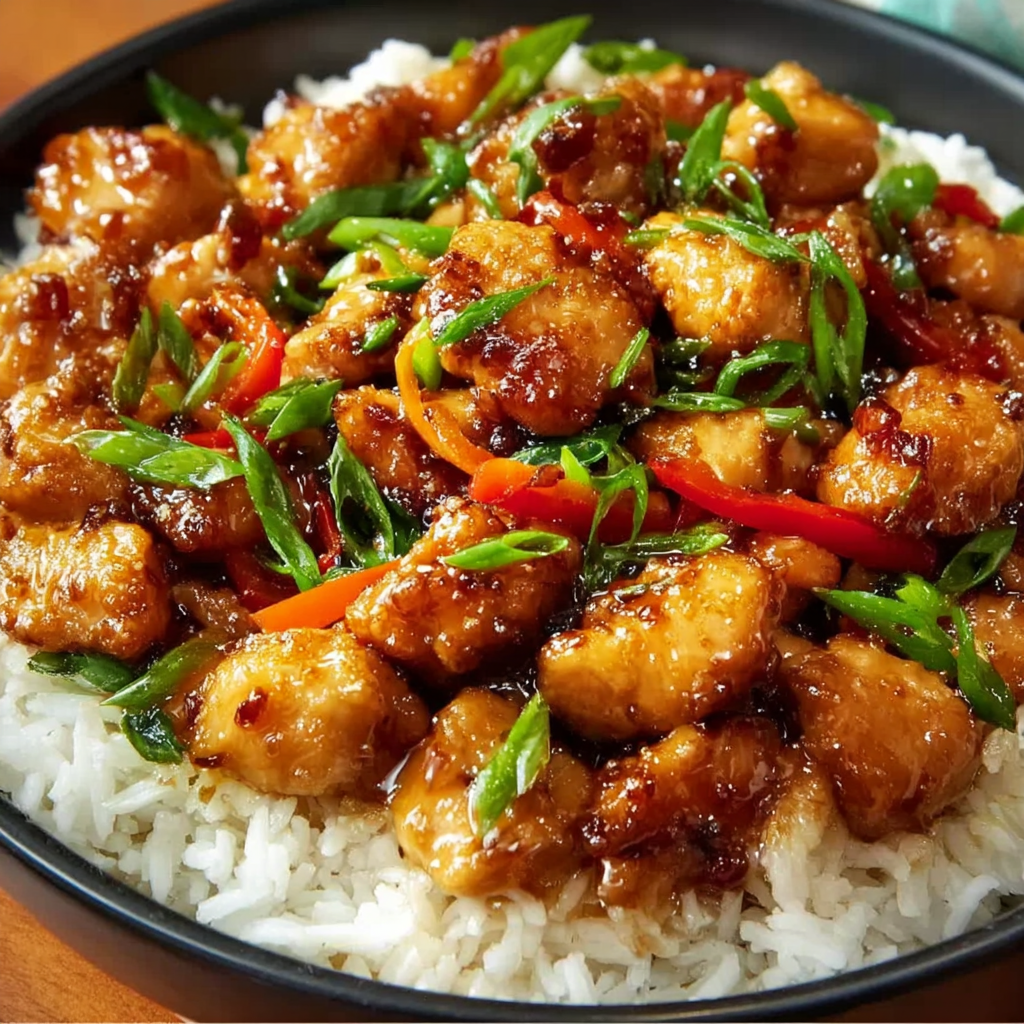
5.Customization Tips & Variations
One of the biggest advantages of Mongolian Chicken is how easy it is to customize. Whether you’re adjusting for dietary needs or simply want to add variety to your meals, this recipe serves as a versatile foundation. Below are creative ways to personalize it without losing its classic appeal.
Swap the Protein
-
Chicken Thighs: Prefer a juicier cut? Substitute boneless, skinless chicken thighs for a richer texture and slightly deeper flavor.
-
Beef: For a traditional twist, try thinly sliced flank steak or sirloin to create Mongolian Beef, the dish that inspired this chicken version.
-
Tofu: Keep it vegetarian by using extra-firm tofu, pressed and pan-fried until golden before adding the sauce.
-
Shrimp: For seafood lovers, quick-cooking shrimp pairs wonderfully with the sweet and savory sauce. Add in the last 3–4 minutes of cooking to avoid overcooking.
Explore more ideas on Pinterest boards like Stir Fry Recipes for protein swaps that match your preferences.
Add Vegetables
This dish also works well as a complete one-pan meal by adding your favorite stir-fry vegetables:
-
Broccoli florets
-
Sliced bell peppers
-
Julienned carrots
-
Snow peas
-
Zucchini
Add vegetables after sautéing the garlic and ginger, and stir-fry for a few minutes before returning the chicken to the pan.
Change the Heat Level
-
For more spice: Add sriracha, chili oil, or extra red pepper flakes.
-
For no spice: Skip the pepper flakes entirely for a sweeter, family-friendly dish.
You’ll find great ideas for spicing up your stir fry on easy Asian dinner inspiration boards.
Diet-Friendly Substitutions
-
Use tamari for a gluten-free version.
-
Replace brown sugar with coconut sugar for a more natural sweetness.
-
Serve with cauliflower rice or zoodles for a low-carb option.
These options make Mongolian Chicken adaptable for various lifestyles while still delivering the same depth of flavor that makes this recipe so popular.
6.What to Serve With Mongolian Chicken
While this dish is satisfying on its own, thoughtful sides elevate the meal. Here are a few serving options that pair perfectly with the rich and sticky sauce of Mongolian Chicken.
-
Steamed Jasmine or White Rice: The go-to base for soaking up every drop of sauce.
-
Brown Rice or Quinoa: Offers a nutty flavor and extra fiber.
-
Cauliflower Rice: A lighter, low-carb alternative that still complements the sauce.
-
Stir-Fried Vegetables: Broccoli, bok choy, or green beans bring balance and texture.
-
Asian Slaw: Adds a fresh, crunchy contrast to the warm, sticky chicken.
-
Egg Rolls or Potstickers: Turn it into a full Asian-inspired dinner spread.
For creative pairing ideas, explore curated Pinterest collections like family dinner ideas.
7. Storage, Reheating, and Make-Ahead Tips
Whether you’re making Mongolian Chicken ahead of time or storing leftovers, the key is preserving its texture and bold flavor. Here’s how to do it right:
Storage
-
Store cooled leftovers in an airtight container in the refrigerator for up to 4 days.
-
For longer storage, freeze for up to 2 months. Thaw overnight in the fridge before reheating.
Reheating
-
Stovetop (Recommended): Heat in a skillet over medium heat with a splash of water to loosen the sauce.
-
Microwave: Use medium power and stir halfway through. Add water if the sauce becomes too thick.
Make-Ahead Tips
-
Prep chicken and sauce separately: Coat and cook the chicken, then store it apart from the sauce to retain crispness.
-
Make sauce in advance: Store the sauce in a jar in the fridge for up to a week and stir before using.
Pinterest boards like chicken recipes for busy nights offer great meal prep variations for time-saving ideas.
8.Nutrition Information
Here’s an estimated nutrition breakdown per serving (based on 4 servings):
-
Calories: 390
-
Protein: 34g
-
Carbohydrates: 28g
-
Fat: 15g
-
Sugar: 17g
-
Sodium: 800mg
To lower the sodium or sugar, opt for low-sodium soy sauce and reduce the brown sugar slightly. Using cauliflower rice can also help lower total carbs.
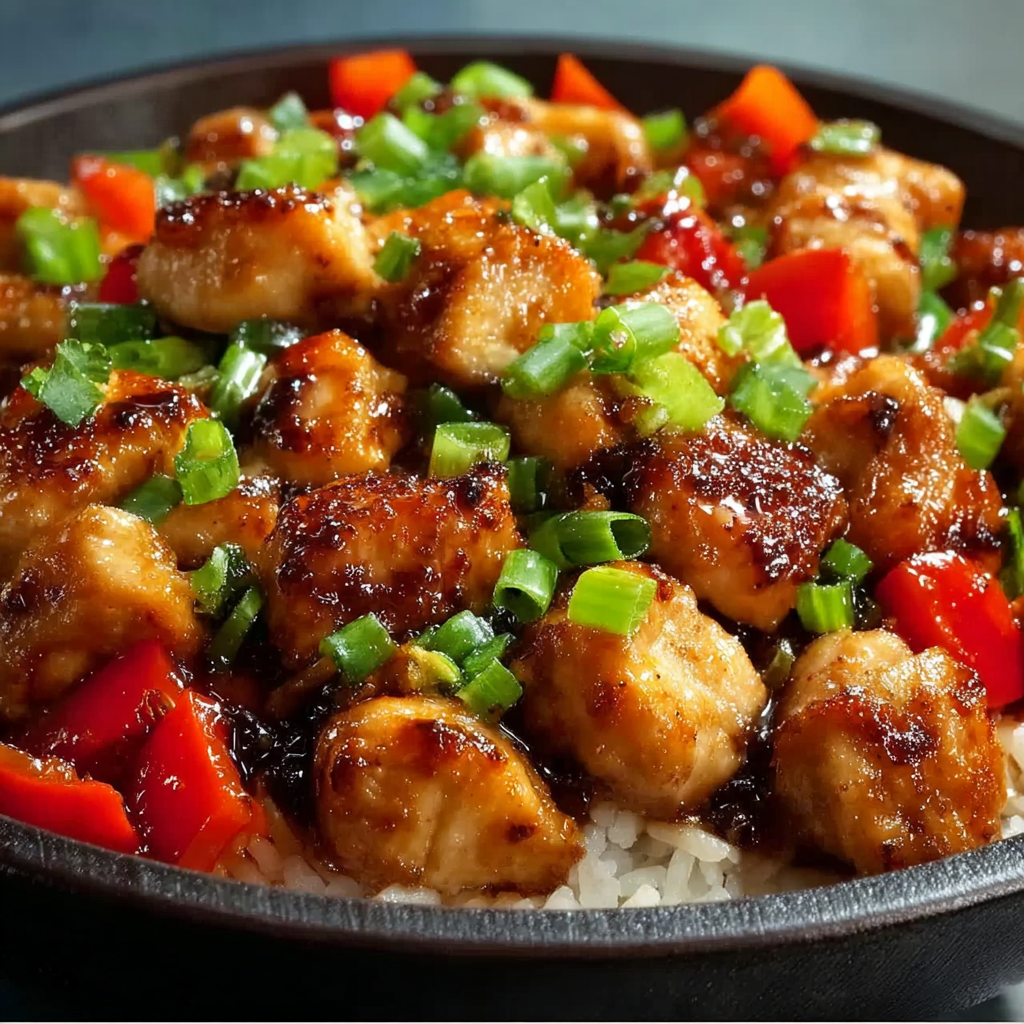
9.FAQs: Mongolian Chicken Answered
What is Mongolian Chicken made of?
Mongolian Chicken is made with thinly sliced chicken breast, coated in cornstarch, pan-fried until crispy, then tossed in a sauce made from soy sauce, brown sugar, garlic, and ginger. It’s a quick stir-fry dish inspired by the flavors of Mongolian Beef.
Is Mongolian Chicken spicy?
Not necessarily. The base recipe includes a small amount of crushed red pepper flakes, but it’s easily adjustable. You can omit them for a milder version or add sriracha or chili oil for more heat.
Can I use chicken thighs instead of chicken breasts?
Yes! Chicken thighs are a great substitute. They’re juicier and more forgiving during cooking, though they may take slightly longer to crisp.
What’s the difference between Mongolian Chicken and General Tso’s Chicken?
Mongolian Chicken is usually less spicy and doesn’t require deep frying. It has a sweeter, more soy-forward sauce, while General Tso’s is spicier, tangier, and often coated in a thicker batter.
Can I make Mongolian Chicken in the slow cooker or air fryer?
While this recipe is best made on the stovetop for crispy texture, you can adapt it. In a slow cooker, skip the cornstarch coating and simmer the sauce with the chicken on low for 3–4 hours. For air frying, coat the chicken lightly in oil and cornstarch, cook at 400°F for 12–15 minutes, then toss in the sauce.
Is Mongolian Chicken gluten-free?
Not by default, but it’s easy to adapt. Use tamari instead of soy sauce, and confirm your cornstarch and other ingredients are certified gluten-free.
Easy Mongolian Chicken With Savory Sauce Weeknight Winner
This Easy Mongolian Chicken is a fast, flavorful stir fry made with crispy chicken breast coated in a sweet and savory sauce of soy, brown sugar, garlic, and ginger. Ready in just 30 minutes, it’s perfect for busy weeknights and easily customizable for various dietary needs. Served over rice and garnished with green onions, this dish brings restaurant-quality taste straight to your home kitchen.
- Author: Clara
Ingredients
- 1.5 pounds boneless, skinless chicken breast, thinly sliced
- ¼ cup cornstarch
- 2 tablespoons vegetable oil
- 3 cloves garlic, minced
- 1 teaspoon fresh ginger, grated
- ½ cup low-sodium soy sauce
- ½ cup water
- ⅓ cup brown sugar
- ½ teaspoon crushed red pepper flakes (optional)
- 2 green onions, sliced (for garnish)
- Cooked white rice, for serving
Instructions
Toss the sliced chicken in cornstarch until well coated. Shake off any excess.
Heat oil in a large skillet over medium-high heat. Add chicken and cook until golden and crispy on all sides. Remove and set aside.
In the same skillet, add garlic and ginger and sauté until fragrant.
Pour in soy sauce, water, and brown sugar. Stir to combine and bring to a simmer.
Add cooked chicken back into the skillet. Stir to coat the chicken in the sauce and simmer for 3–5 minutes until the sauce thickens slightly.
Sprinkle in crushed red pepper flakes if using.
Serve over cooked rice and garnish with sliced green onions.
Notes
-
For crispier chicken: Be sure to shake off excess cornstarch and don’t overcrowd the pan.
-
Make it low-carb: Serve over cauliflower rice and reduce the sugar by half.
-
Meal prep tip: Cook the chicken and sauce separately and combine right before serving for best texture.
-
Add-ins: Try broccoli, bell peppers, or carrots for extra veggies.
-
Storage: Keeps well in the fridge for 4 days or freezer for 2 months.
